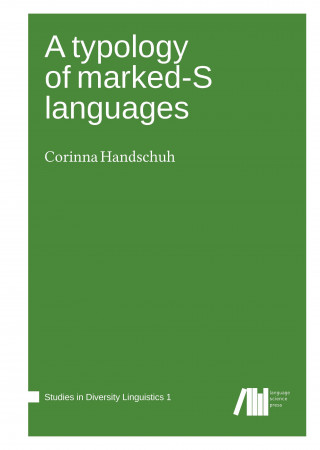
Code: 12826103
A typology of marked-S languages
by Corinna Handschuh
Case-systems all over the world exhibit striking similarities. In most languages intransitive subjects (S) receives less overt marking than one of the two transitive arguments (agent-like A or patient-like P); the other one of the ... more
- Language:
 English
English - Binding: Hardback
- Number of pages: 280
Publisher: Language Science Press, 2015
- More about this

28.74 €
RRP: 31.85 €
You save 3.11 €

In stock at our supplier
Shipping in 10 - 12 days
You might also like
-

El Muro: Conquistate a Ti y Luego El Mundo = the Wall
16.53 € -4 % -

Nie seplenie
5.64 € -

Messages
11.39 €
Give this book as a present today
- Order book and choose Gift Order.
- We will send you book gift voucher at once. You can give it out to anyone.
- Book will be send to donee, nothing more to care about.
More about A typology of marked-S languages
You get 72 loyalty points
 Book synopsis
Book synopsis
Case-systems all over the world exhibit striking similarities. In most languages intransitive subjects (S) receives less overt marking than one of the two transitive arguments (agent-like A or patient-like P); the other one of these two arguments is usually encoded by the same form as S. In some languages the amount of overt marking is identical between S, A, and P. But hardly ever does the S argument receive more overt marking than A or P. Yet there are some languages that do not follow this general pattern. This book is about those languages that behave differently, the marked-S languages. Marked-S languages are well-known to be found in East Africa, where they occur in two different language families, Afro-Asiatic and Nilo-Saharan. They can also be found in North-Western America and the Pacific region. This book is the first investigation of marked S-languages that treats the phenomenon on a global scale. The study examines the functional distribution of the two main case-forms, the form used for S (S-case) and the case-form of the transitive argument which receives less marking (the zero-case). It offers a very fine-grained perspective considering a wide range of constructions. The contexts in which the case-marking patterns are investigated include nominal, existential and locational predication, subjects in special discourse function (e.g. focused constituents), subjects of passives and dependent clauses, as well as the forms used for addressing someone (vocative form) and for using a noun in isolation (citation form). Apart from the functional distribution of case forms, the formal means of marking are also considered. The main focus is on the synchronic description and comparison of marked-S languages, but historical explanations for the unusual case-marking pattern are also discussed.
 Book details
Book details
28.74 €
- Full title: A typology of marked-S languages
- Author: Corinna Handschuh
- Language:
 English
English - Binding: Hardback
- Number of pages: 280
- EAN: 9783944675701
- ISBN: 3944675703
- ID: 12826103
- Publisher: Language Science Press
- Weight: 654 g
- Dimensions: 240 × 170 × 19 mm
- Date of publishing: 10. July 2015
Trending among others
-

The Book of Bill
23.70 € -14 % -

Gravity Falls Journal 3
16.43 € -23 % -

Berserk Deluxe Volume 1
44.28 € -12 % -

Pumpkin Spice Cafe
16.94 € -15 % -

Berserk Deluxe Volume 2
52.14 € -

White Nights
3.52 € -23 % -

It ends with us
8.67 € -19 % -

48 Laws Of Power
17.95 € -29 % -

A Little Life
17.44 € -

Gilmore Girls: The Official Advent Calendar
28.84 € -18 % -

Atomic Habits
15.93 € -14 % -

Berserk Deluxe Volume 3
48.81 € -3 % -

Jujutsu Kaisen, Vol. 23
11.09 € -15 % -

Surrounded by Idiots
10.48 € -29 % -

The 48 Laws of Power
24.50 € -5 % -

Berserk Deluxe Volume 4
45.18 € -10 % -

The Official Stardew Valley Cookbook
22.38 € -19 % -

Iron Flame
16.23 € -18 % -

Berserk Deluxe Volume 5
50.43 € -

A Curse For True Love
10.38 € -12 % -

A Good Girl's Guide to Murder
8.16 € -14 % -

It Starts with Us
10.68 € -17 % -

Powerless
10.48 € -23 % -

Court of Mist and Fury
9.37 € -18 % -

Psychology of Money
18.85 € -4 % -

The Husky and His White Cat Shizun: Erha He Ta de Bai Mao Shizun (Novel) Vol. 6
16.13 € -19 % -

Twisted Love
9.78 € -24 % -

Twisted Hate
10.18 € -20 % -

Chainsaw Man, Vol. 16
11.29 € -13 % -

English File: Intermediate: Student's Book with Online Practice
25.61 € -7 % -

Berserk Deluxe Volume 6
51.13 € -

Twisted Lies
9.78 € -24 % -

Reckless
10.28 € -20 % -

Gravity Falls: Lost Legends
17.74 € -15 % -

English File Upper Intermediate Student's Book with Student Resource Centre Pack (4th)
44.07 € -4 % -

Headway: Elementary: Student's Book with Online Practice
24.91 € -8 % -

Twisted Games
9.78 € -17 % -

Court of Thorns and Roses Paperback Box Set (5 books)
50.02 € -20 % -

Court of Thorns and Roses
9.27 € -19 % -

Meow
20.77 € -

Everything I Know About Love
10.38 € -29 % -

Vagabond (VIZBIG Edition), Vol. 1
24.50 € -

A Court of Wings and Ruin
10.78 € -6 % -

Once Upon A Broken Heart
9.88 € -23 % -

The Ballad of Never After
10.08 € -21 % -

Headway: Elementary: Workbook Without Key
13.91 € -

The Courage To Be Disliked
10.99 € -27 % -

SOLO LEVELING V09
17.85 € -14 % -

A Court of Silver Flames
10.08 € -15 %
Osobní odběr Bratislava a 2642 dalších
Copyright ©2008-24 najlacnejsie-knihy.sk Wszelkie prawa zastrzeżonePrywatnieCookies


 Vrácení do měsíce
Vrácení do měsíce Zdarma od 49.99 €
Zdarma od 49.99 € 02/210 210 99 (8-15.30h)
02/210 210 99 (8-15.30h)